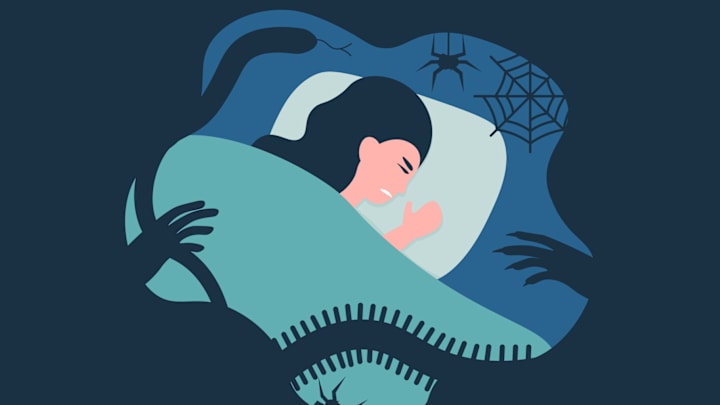Getting a solid night’s rest when you’re sick can seem like an unattainable goal for any number of reasons. It’s difficult to fall asleep and stay asleep when you’re plagued by a stuffy nose, a ceaseless cough, or some combination of those and other intolerable symptoms.
Fevers can make quality sleep even harder, thanks in part to fever dreams: especially vivid, weird, or downright disturbing dreams that occur when you have a fever. As the Sleep Foundation explains, fever dreams sometimes involve “spatial distortion,” such as moving walls and melting objects; “threats or danger,” which can be anything from insects to terrorists; and illness. If you were to have a dream fitting this description when you weren’t sick, you might just write it off as a garden-variety nightmare. But since people seem to experience such strange dreams more often during fevers, it’s given rise to the idea that the two things must be linked.
It’s not a new concept. In fact, English speakers have been talking about fever dreams at least as far back as the early 19th century. The first known reference to the term comes from an 1801 letter written by Samuel Taylor Coleridge. “Even the Forms which struck terror into me in my fever-dreams were still forms of Beauty,” he wrote. According to the Oxford English Dictionary, fever dream probably derives from an even older German phrase: Fiebertraum, meaning fever dream.
While there’s a lot about fever dreams we don’t know, there is at least a little evidence supporting the theory that some people’s fever dreams are different from their regular dreams. In one retrospective study from 2016, researchers asked 62 people to describe past fever dreams and found them to be “more bizarre, more emotionally intense, and often negatively toned than [regular] dream[s] from an age- and gender matched sample.” Of the 164 people who participated in a 2020 survey (co-conducted by dream researcher Michael Schredl, who also co-authored the 2016 study), 100 reported fever dreams. The researchers noted that these dreams “included more references to health and temperature perception compared to ‘normal’ most recent dreams.”
As for why fevers beget bizarre nightmares, scientists have some ideas.“[One] theory is that the brain doesn’t process sensations normally when we have a fever,” Dr. Beth Malow, director of Vanderbilt University Medical Center’s sleep division, told Health in 2020. So burning up in your bed might just manifest itself in a dream full of melting objects and seemingly unrelated perils.
The reason fever dreams seem so vivid could be related to fever’s tendency to interfere with REM sleep: the period of deepest sleep during which most dreams occur. As Dr. Alcibiades Rodriguez, medical director of NYU Langone Health’s Comprehensive Epilepsy Center-Sleep Center, told Health, “If we get a spike in fever during REM sleep, we may feel more uncomfortable and have micro-arousals (shifts between deep and light sleep). This increases the likelihood of us remembering our dreams.”
In short, from a scientific standpoint, fever dreams are still a pretty mysterious phenomenon. But the figurative meaning of the term fever dream is slightly clearer. Basically, it can describe anything—a plan, a story, a piece of art, a TV show, an acid trip, etc.—that seems disorienting, separated from reality, or just exceptionally evocative. And considering that actual fever dreams are typically bad ones, calling your friend’s new short film a “fever dream” might not be the compliment you were hoping to convey.
